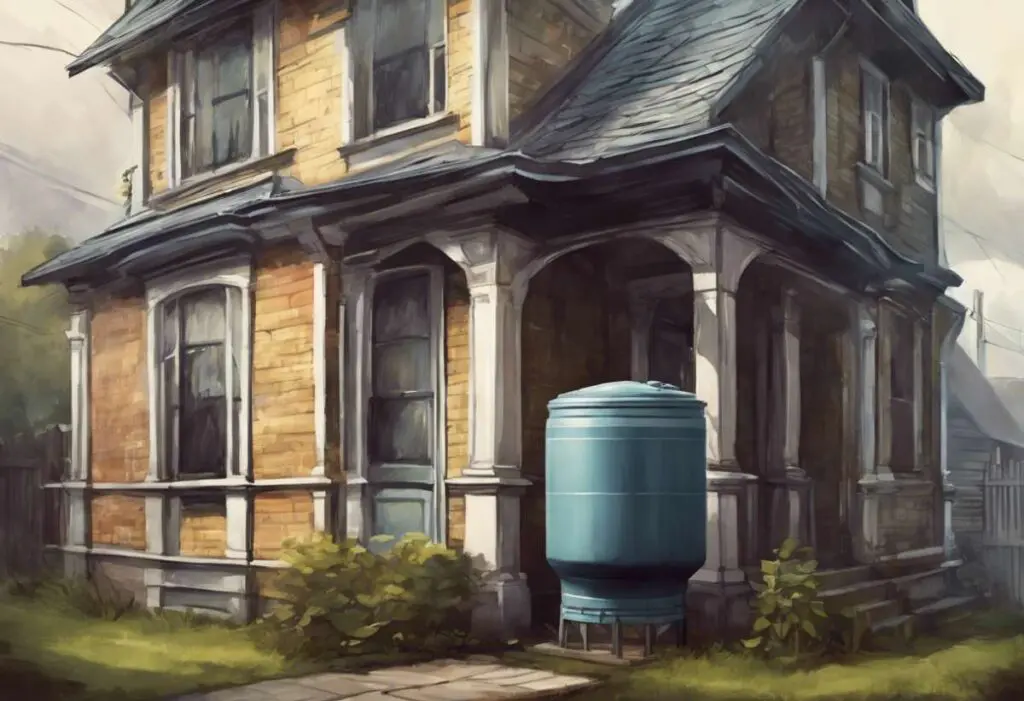Whether it’s drinking water for homes, irrigation water for crops, or firefighting water for emergencies, water tanks play a crucial role in ensuring water availability and security.
Adding a water storage tank to your home or business also contributes to efficient water management and conservation efforts, thus saving this vital resource from being wasted – particularly important these days as water supplies are dwindling due to climate change.
In this guide, we’ll explore the different types of water storage tanks, sorted by type of material, location of installation, and shape/configuration. Lastly, we offer a list of buying tips to ensure you spend your money wisely and select the right water storage tank to meets all your requirements.
What Is a Water Storage Tank?
A water storage tank (also known as a cistern, water tank or water cistern tank) is a container specifically designed to store and hold water for later use. They range in size from small household tanks to large industrial reservoirs and come in various materials and configurations. Water tanks can be used to store both potable (drinking) water and non-potable water, such as rainwater, irrigation water, or industrial process water.
Different Use Cases for Water Storage Tanks
Residential – Residential water tanks are used to store drinking water, provide water for household chores, and supplement municipal water supplies in areas with unreliable water access. They are used for a house, RV or other property with enough space to store the tank.
Agriculture – Agricultural water tanks are used for irrigation, livestock watering, and crop spraying to ensure a reliable water supply for farming operations.
Industrial – Industrial water tanks are used for processes such as cooling, manufacturing, and processing, as well as for storing wastewater, chemicals, and other liquids used in industrial operations.
Commercial – Commercial water tanks are used in hotels, resorts, restaurants, and other commercial establishments to provide water for facilities, amenities, and guest use.
Rainwater harvesting – Water storage tanks are used in rainwater harvesting systems where they are connected to down pipes to channel water that was collected from the roof.
Fire protection – Fire water tanks are strategically placed in buildings, factories, and rural areas to provide water for firefighting in case of emergencies.
Emergency preparedness – Emergency water tanks serve as reserve water supplies during natural disasters, emergencies, or disruptions to municipal water systems, ensuring access to clean water for drinking, sanitation, and hygiene.
Types of Water Storage Tanks (By Material)

1. Plastic Water Storage Tanks (Polyethylene)
Plastic water tanks are among the most common types of cisterns as they are affordable and versatile. They are typically made from high-density polyethylene (HDPE) or linear low-density polyethylene (LLDPE) and come in a variety of shapes and sizes, including vertical and horizontal models.
Features
Lightweight – Polyethylene water tanks are lightweight, making them easy to transport and install.
Durable – HDPE and LLDPE are resistant to corrosion and degradation, ensuring the longevity of the cistern.
Cost-effective – Polyethylene cisterns are relatively affordable compared to other materials.
Versatility – They can be installed above or below ground, depending on the available space and requirements.
Advantages
Ease of installation – Polyethylene cisterns are relatively easy to install, requiring minimal specialized equipment.
Low maintenance – They require little maintenance beyond periodic cleaning.
Compatibility – Polyethylene is non-toxic, making it suitable for storing potable water.
Disadvantages
UV exposure – Polyethylene cisterns may degrade when exposed to prolonged sunlight, so they should be installed in shaded areas or covered.
Limited sizes – Larger polyethylene cisterns may be more challenging to find and transport.
2. Concrete Cisterns
Concrete cisterns are another popular option, especially for larger storage capacities. They are typically constructed on-site using reinforced concrete and can be customized to fit specific dimensions and requirements.
Features
Strength and durability – Concrete cisterns are highly durable and can withstand harsh weather conditions.
Customizable – They can be designed to fit unique shapes and sizes, making them suitable for various installation locations.
Insulation – Concrete provides natural insulation, helping to regulate water temperature inside the cistern.
Advantages
Longevity – Concrete water tanks have a long lifespan, often lasting several decades with proper maintenance.
Large capacities – They can store large volumes of rainwater, making them ideal for properties with high water demand.
Fire resistance – Concrete is non-combustible, providing added safety in areas prone to wildfires.
Disadvantages
Installation complexity – Constructing concrete cisterns requires skilled labor and may involve longer installation times compared to prefabricated options.
Potential cracking – Improperly constructed concrete cisterns may develop cracks over time, leading to water leakage.
Cost – Concrete cisterns tend to be more expensive than polyethylene alternatives, particularly for smaller capacities.
3. Metal Water Storage Tanks
Metal water storage tanks, typically made from galvanized steel, stainless steel or corrugated steel, offer a durable and corrosion-resistant option for rainwater storage. They are commonly used in both residential and commercial rainwater harvesting systems.
Features
Corrosion resistance – Galvanized steel and stainless steel are highly resistant to corrosion, ensuring the integrity of the cistern.
Strength – Metal cisterns are robust and can withstand heavy loads and external pressures.
Aesthetic appeal – Some homeowners appreciate the industrial aesthetic of metal cisterns, which can be left exposed or integrated into landscaping designs.
Advantages
Longevity – Properly maintained metal cisterns can last for several decades without significant degradation.
Rodent resistance – Metal cisterns are less susceptible to damage from rodents and pests compared to other materials.
Recyclability – At the end of their lifespan, metal cisterns can be recycled, reducing environmental impact.
Disadvantages
Cost – Metal cisterns tend to be more expensive than polyethylene alternatives, particularly for larger capacities.
Potential corrosion – While galvanized and stainless steel are corrosion-resistant, they may still degrade over time, especially in acidic environments.
Maintenance – Periodic inspections and maintenance are necessary to prevent corrosion and ensure the cistern’s longevity.
4. Fiberglass Water Storage Tanks
Fiberglass water tanks offer a lightweight and durable alternative for rainwater storage. They are constructed from fiberglass-reinforced plastic (FRP) and are available in various shapes and sizes to suit different installation requirements.
Features
Lightweight – Fiberglass tanks are lightweight, making them easy to transport and install.
Corrosion resistance – Fiberglass is highly resistant to corrosion, ensuring the long-term integrity of the cistern.
Insulation – Fiberglass provides natural insulation, helping to maintain stable water temperatures inside the cistern.
Advantages
Durability – Fiberglass cisterns have a long lifespan and can withstand exposure to UV radiation and harsh weather conditions.
Customization – They can be manufactured to fit specific dimensions and configurations, allowing for versatile installation options.
Low maintenance – Require minimal maintenance beyond periodic cleaning and inspections.
Disadvantages
Cost – Fiberglass water storage tanks may be more expensive than polyethylene options but are typically more affordable than concrete or metal alternatives.
Installation – Care must be taken during installation to prevent damage to the fiberglass shell.
UV protection – Fiberglass water tanks may require UV-resistant coatings or protective covers to prevent degradation from sunlight exposure.
5. Water Storage Bladder Tanks (PVC, Polyurethane, Rubber)
Bladder tanks, also known as flexible or collapsible tanks, are a portable and space-saving option for water storage. They are made from reinforced PVC, polyurethane, rubber or similar materials and can be installed in areas where traditional cisterns are impractical or unavailable.
Features
Portability – Bladder tanks can be easily transported and relocated, making them suitable for temporary rainwater storage.
Space-saving – When empty, bladder cisterns can be collapsed for compact storage, minimizing space requirements.
Versatility – They can be installed in unconventional locations, such as crawl spaces, basements, or under decks.
Advantages
Affordability – Often more cost-effective than rigid cistern options, especially for smaller capacities.
Easy Installation – Setting up a bladder tank typically requires minimal time and labor compared to traditional cisterns.
Adaptability – Can be used in conjunction with other rainwater harvesting systems or as standalone storage solutions.
Disadvantages
Durability – While reinforced, bladder tanks may be more susceptible to punctures or tears compared to rigid cisterns.
Limited capacity – Available in smaller capacities compared to rigid options, making them less suitable for high-volume storage.
Different Types of Water Storage Tanks (By Shape/Configuration)

Cylindrical Water Tanks
Cylindrical tanks are one of the most common shapes of water storage tanks and offer efficient use of space. They can be installed vertically or horizontally, depending on available space and installation requirements. They offer excellent structural integrity and are suitable for storing large volumes of water.
Rectangular Water Tanks
Rectangular tanks are often used in situations where space is limited or where a low-profile tank is desired, such as under decking or in crawl spaces.
Slimline Water Tanks
The tall and narrow shape of slimline water tanks allow them to fit conveniently even in tight spaces making them highly suitable for urban areas with space constraints. Coupled with varying colors and sizes, these tanks can seamlessly blend with any existing structure without much disturbance.
Modular Water Tanks
Modular tanks consist of multiple interconnected modules that can be assembled on-site to create custom-sized water storage solutions. They are versatile and can be adapted to fit various installation requirements.
Baffled Water Tanks
This type of tank has baffle plates or uses grooves or holes within the construction of the tank to prevent sloshing around of water while it is in transport. It is an ideal choice for those who drive around with water tanks like window cleaners.
Bolted Steel Water Tanks
A bolted steel water tank is a type of water storage tank constructed from steel panels that are bolted together on-site to create a tank structure. Typically used for storing large volumes of water for various applications, including municipal water supply, industrial processes, firefighting, and agricultural irrigation.
Different Types of Water Storage Tanks (By Location of Installation)
Above Ground Water Storage Tanks
These tanks are installed on the surface, either indoors or outdoors, and are visible above the ground. While above ground tanks are easy to install and access, they may be susceptible to weathering and UV degradation if not properly protected or treated. Commonly made from materials like polyethylene, steel, or fiberglass.
Below Ground Water Storage Tanks
Also known as an underground or buried tank, these storage containers are installed beneath the surface, typically in the ground. Constructed from materials like concrete, polyethylene, or fiberglass, these tanks require excavation for installation and are accessed through manholes or risers.
Below ground tanks offer benefits such as protection from sunlight, reducing algae growth and evaporation, and insulation to maintain stable water temperatures. However, installation may be costly and time-consuming, and access for maintenance can be challenging compared to above ground tanks.
Overhead Water Tanks
Also referred to as an elevated tank or rooftop tank, it’s a container mounted at an elevated height above the ground level. Made from materials such as steel or concrete, these tanks are supported by structures like towers, columns, or rooftops and are connected to a water distribution system to provide gravity-fed water pressure.
Overhead tanks are commonly used in areas with irregular or low water pressure to ensure adequate water flow to buildings and facilities. While they offer benefits such as consistent water pressure and space-saving advantages, they require additional infrastructure for support and may be susceptible to damage from environmental factors if not properly designed and maintained.
Tips on Choosing the Right Water Storage Tank
A water storage tank is a considerable investment. If you pick a poorly designed cistern it may only last a few years or if you pick the wrong one for your needs you can kiss your hard-earned dollars goodbye. Choosing the right water storage tank requires looking at a number of factors to ensure it meets your needs in terms of capacity, durability, safety, and cost-effectiveness.
Capacity – The first step in choosing a water tank is to determine the amount of water you need to store (check out this handy rainwater harvesting calculator to help you determine your daily and annual water needs). Consider factors like household size, water usage patterns, and emergency requirements. Choose a tank with adequate capacity to meet your needs without being excessively large so you don’t purchase more than you need, wasting both money and resources.
Material – Water tanks come in different materials, each with its pros and cons. We’ve thoroughly covered each of the materials above. Look at the advantages and disadvantages of each to select the right material for your needs.
Location and space – Consider where you plan to install the tank and the available space. Tanks can be installed above ground, underground, or even elevated on structures or rooftops, which we’ve covered earlier in this guide. Ensure the location is easily accessible for maintenance and installation. Go back to the previous section to help you select the right location.
Quality and durability – Look for tanks made from high-quality materials that are designed to withstand the elements and prolonged use. Check for certifications and warranties that indicate the tank’s quality and durability.
UV resistance – If the tank will be exposed to sunlight, ensure it has UV-resistant properties to prevent degradation and algae growth.
Insulation – If you live in an area with extreme temperatures, consider insulated tanks to prevent freezing in winter or overheating in summer.
Fittings and accessories – Check the tank for fittings like inlet, outlet, overflow, and access points. Ensure these fittings are compatible with your plumbing system and any additional accessories you may need, such as filters or pumps.
Cost – Compare prices from different manufacturers and suppliers, but don’t compromise on quality for a lower price. Remember the proverb “buy cheap, buy twice.” It’s not worth buying cheap if you’re going to have to replace it in a few years – that will not just cost you more, but cost’s the planet more in terms of additional resource usage. Also, consider the long-term cost-effectiveness of the tank, including maintenance and potential savings on water bills.
Local regulations – Check local regulations and building codes regarding water storage tanks. Ensure the tank you choose complies with these regulations to avoid any legal issues or fines.
Manufacturer reputation – Choose a reputable manufacturer or supplier with a track record of providing high-quality water storage tanks and excellent customer service. Read reviews and testimonials from other customers to gauge the company’s reliability.
Here’s a video guide exploring how to choose the right water tank:


